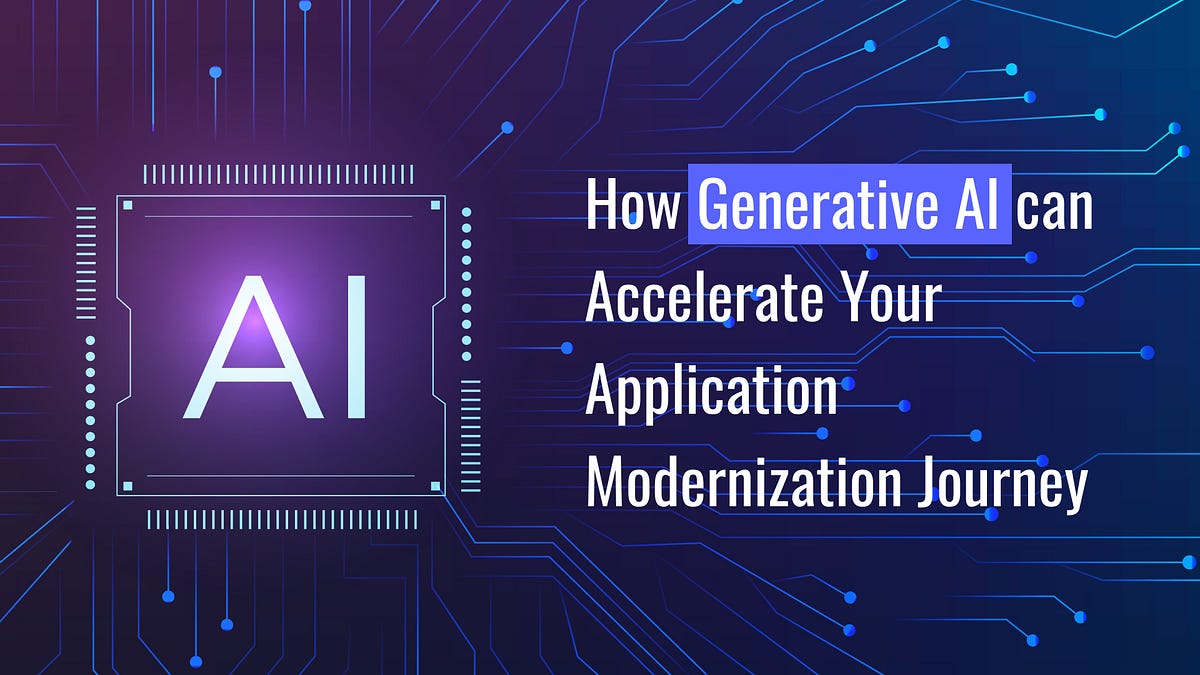
Once upon a time, there was no robotics in healthcare. The retail stores didn’t have any automated check-outs. Smart fintech apps could not offer personalized investment recommendations to their customers. Those were the times of legacy systems. Then along came artificial intelligence, IoT, data analytics, and cloud. Cybercriminals got smarter and developed more malicious ways to attack data centers. Customers started to get annoyed with complex sign-up requirements, disjointed buying journeys, and disorganized itineraries. Thus came the adventurous game of legacy application modernization. Application modernization services help focus on keeping up with customer experience demands while protecting the applications. But in the face of growing cyberattacks, unplanned downtimes, and compliance issues, the next modernization stage needs a power-up. Fortunately, we’ve reached the time when the stars are aligning themselves to welcome the arrival of generative AI!
Per the latest report by Market Research Future, the application modernization market is projected to grow up to USD 38.7 billion by 2032. This isn’t surprising if you consider that IT executives, CTOs, CIOs, and technology leaders are all anxious to keep the ball rolling in a market more dynamic than ever. If integrated mindfully and strategically, generative AI can help maintain this delicate balance between the all-over-the-map customer demands and long-term business continuity and security.
So, how do the players of modernization fight these three bosses with AI potion?
Enterprise application containers, such as Docker and Kubernetes, gained popularity for their ability to package applications and their dependencies into standardized units. They are known to provide a way to isolate applications from their underlying infrastructure, simplifying deployment and management tasks. However, managing containerized applications at scale can be complex, requiring specialized skills and tools. Additionally, traditional deployment practices may still involve manual steps, leading to slower release cycles and increased risk of errors. Let us understand these concerns through our three bosses — security, customer experience, and business continuity.
Problems like breakout vulnerabilities or misconfigurations can easily turn containers into potential attack vectors. Deployment of insecure container images can also be exploited for malicious breaches and data leaks. Therefore, application modernization needs to evolve to secure the CI/CD pipelines with automated security checks, static and static code analysis, and vulnerability scanning.
Challenges related to inept container management can lead to service downtimes, inconsistent performance, and unforeseen misconfigurations. Thus, even with modernization, businesses may not expect to deliver top-notch customer experience. It is imperative that the modernization strategies are mindful of shorter release cycles, frequent updates, and early issue detection and addressing.
Even with all their promises of scalability and resilience, modern containerized platforms can lack proper monitoring measures, scheduling conflicts, and network disruptions. This can prolong the downtimes and directly hamper business continuity due to a lack of quick response and error-prone deployment.
Despite the concerns described above, application modernization continues to be the reliable next step thanks to significant opportunities for service improvement and business growth. This is why an ally like Gen-AI needs to step in to boost all that’s great about modernization.
Adopting AI goes beyond mere keyword insertions on business websites. With the promise of personalization and customization, the technology can help with more than just creative content generation. It offers future-proofing, decision-making, competitive advantage, and much more. By integrating AI into modernization strategies, organizations can emerge triumphant against the three bosses. Here’s how the adventure will unfold.
Generative AI can automate various aspects of security checks, threat detection, and remediation. This automation accelerates the detection, response, and resolution of security issues, reducing manual effort, minimizing human error, and enhancing the overall security posture of software development processes. By continuously scanning code for vulnerabilities, analyzing patterns, and generating alerts for potential threats, it can minimize the risk of deploying insecure code into production. Here are some of it’s essential modernization enhancements in terms of security:
- Dynamic Threat Detection: AI can dynamically monitor CI/CD pipelines for suspicious activities or deviations from normal behavior that may indicate security threats. By analyzing real-time data, generative AI can detect and respond to emerging threats proactively, enhancing the overall security posture of the software development process.
- Predictive Analytics: Gen-AI can leverage predictive analytics to identify potential security risks based on historical data from CI/CD pipelines. By analyzing patterns and trends, AI can predict future security threats and recommend effective preventive measures to mitigate risks.
- Automated Remediation: Generative AI can automate the remediation of security vulnerabilities identified during the CI/CD process. By generating code patches or configuration changes automatically, AI accelerates the remediation process, reducing the time to resolution and minimizing the impact on business operations.
- Continuous Improvement: AI can contribute to the continuous improvement of security practices within CI/CD pipelines. By analyzing data on security incidents and outcomes, AI can identify areas for improvement, recommend best practices, and optimize security controls to enhance overall security posture and resilience.
AI can enable organizations to be more agile in delivering features and updates to customers. This can reduce operational disruptions and allow businesses to respond quickly to customer feedback without struggling with downtime.
Faster Delivery of Features: Imagine the customers demanding a new feature on your application via channels like social media, Play Store feedback, or more. With AI, developers can work faster behind the scenes, and leverage the use of smart tools to improve and develop features more quickly. Instead of waiting for months, customers might get a cool new feature in just a few weeks.
Reliable Updates: With automated testing and deployment processes, generative AI can help test the updates thoroughly in less time before they are released into production. This means no annoying app crashes or performance failures.
Access to Latest Features: By delivering updates to production more frequently and reliably, AI can ensure that customers have access to the latest features and improvements. This enhances customer satisfaction and loyalty by providing them with a continuous stream of value-added updates.
AI offers features like predictive maintenance, adaptive resource allocation, and autonomous decision-making. These can help proactively manage operations and anticipate any challenges, thereby ensuring uninterrupted business continuity and operational efficiency.
- Rapid and Reliable Deployments: AI can help businesses with rapid and reliable software deployments by automating testing and deployment processes. This ensures that updates are deployed consistently and efficiently, minimizing the risk of disruptions or downtime.
- Quick Rollback: In the event of failures or issues during deployment, Gen-AI can facilitate quick rollback to previous versions. This allows organizations to restore services promptly and minimize business disruptions, ensuring continuity of operations.
Every adventure comes with its challenges to face, rewards to win, and stories to tell. While saving the kingdoms of contemporary digital ecosystems, it is essential that our heroes of application modernization have all the help they need. Generative AI can prove to be the reliable power boost in this journey as, more than anything else, it can help business decision-makers translate their pain points directly into digital strategies. Therefore, the application modernization plans need to accommodate Gen-AI to ensure that the complex applications and platforms can keep up with the business needs of today and beyond.
Discover more from reviewer4you.com
Subscribe to get the latest posts to your email.





